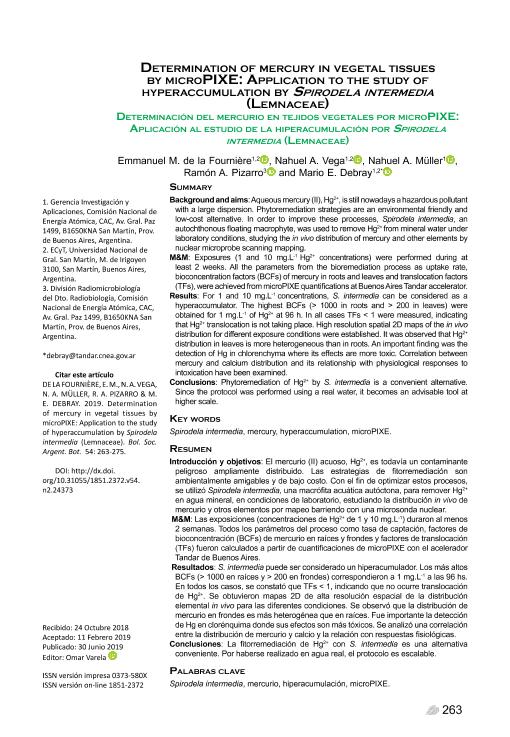Artículo
Background and aims: Aqueous mercury (II), Hg2+, is still nowadays a hazardous pollutant with a large dispersion. Phytoremediation strategies are an environmental friendly and low-cost alternative. In order to improve these processes, Spirodela intermedia, an autochthonous floating macrophyte, was used to remove Hg2+ from mineral water under laboratory conditions, studying the in vivo distribution of mercury and other elements by nuclear microprobe scanning mapping. M&M: Exposures (1 and 10 mg.L-1 Hg2+ concentrations) were performed during at least 2 weeks. All the parameters from the bioremediation process as uptake rate, bioconcentration factors (BCFs) of mercury in roots and leaves and translocation factors (TFs), were achieved from microPIXE quantifications at Buenos Aires Tandar accelerator. Results: For 1 and 10 mg.L-1 concentrations, S. intermedia can be considered as a hyperaccumulator. The highest BCFs (> 1000 in roots and > 200 in leaves) were obtained for 1 mg.L-1 of Hg2+ at 96 h. In all cases TFs < 1 were measured, indicating that Hg2+ translocation is not taking place. High resolution spatial 2D maps of the in vivo distribution for different exposure conditions were established. It was observed that Hg2+ distribution in leaves is more heterogeneous than in roots. An important finding was the detection of Hg in chlorenchyma where its effects are more toxic. Correlation between mercury and calcium distribution and its relationship with physiological responses to intoxication have been examined. Conclusions: Phytoremediation of Hg2+ by S. intermedia is a convenient alternative. Since the protocol was performed using a real water, it becomes an advisable tool at higher scale. Introducción y objetivos: El mercurio (II) acuoso, Hg2+, es todavía un contaminante peligroso ampliamente distribuido. Las estrategias de fitorremediación son ambientalmente amigables y de bajo costo. Con el fin de optimizar estos procesos, se utilizó Spirodela intermedia, una macrófita acuática autóctona, para remover Hg2+ en agua mineral, en condiciones de laboratorio, estudiando la distribución in vivo de mercurio y otros elementos por mapeo barriendo con una microsonda nuclear. M&M: Las exposiciones (concentraciones de Hg2+ de 1 y 10 mg.L-1) duraron al menos 2 semanas. Todos los parámetros del proceso como tasa de captación, factores de bioconcentración (BCFs) de mercurio en raíces y frondes y factores de translocación (TFs) fueron calculados a partir de cuantificaciones de microPIXE con el acelerador Tandar de Buenos Aires. Resultados: S. intermedia puede ser considerado un hiperacumulador. Los más altos BCFs (> 1000 en raíces y > 200 en frondes) correspondieron a 1 mg.L-1 a las 96 hs. En todos los casos, se constató que TFs < 1, indicando que no ocurre translocación de Hg2+. Se obtuvieron mapas 2D de alta resolución espacial de la distribución elemental in vivo para las diferentes condiciones. Se observó que la distribución de mercurio en frondes es más heterogénea que en raíces. Fue importante la detección de Hg en clorénquima donde sus efectos son más tóxicos. Se analizó una correlación entre la distribución de mercurio y calcio y la relación con respuestas fisiológicas. Conclusiones: La fitorremediación de Hg2+ con S. intermedia es una alternativa conveniente. Por haberse realizado en agua real, el protocolo es escalable
Determination of mercury in vegetal tissues by microPIXE: Application to the study of hyperaccumulation by Spirodela intermedia (Lemnaceae)
Título:
Determinación del mercurio en tejidos vegetales por microPIXE: Aplicación al estudio de la hiperacumulación por Spirodela intermedia (Lemnaceae)
De La Fournière, Emmanuel M.; Vega, Nahuel Agustín ; Müller, Nahuel Agustín; Pizarro, Ramón Augusto; Debray, Mario Ernesto
; Müller, Nahuel Agustín; Pizarro, Ramón Augusto; Debray, Mario Ernesto
 ; Müller, Nahuel Agustín; Pizarro, Ramón Augusto; Debray, Mario Ernesto
; Müller, Nahuel Agustín; Pizarro, Ramón Augusto; Debray, Mario Ernesto
Fecha de publicación:
20/06/2019
Editorial:
Sociedad Argentina de Botánica
Revista:
Boletín de la Sociedad Argentina de Botánica
ISSN:
0373-580X
e-ISSN:
1851-2372
Idioma:
Inglés
Tipo de recurso:
Artículo publicado
Clasificación temática:
Resumen
Palabras clave:
HYPERACCUMULATION
,
MERCURY
,
MICROPIXE
,
SPIRODELA INTERMEDIA
Archivos asociados
Licencia
Identificadores
Colecciones
Articulos(SEDE CENTRAL)
Articulos de SEDE CENTRAL
Articulos de SEDE CENTRAL
Citación
De La Fournière, Emmanuel M.; Vega, Nahuel Agustín; Müller, Nahuel Agustín; Pizarro, Ramón Augusto; Debray, Mario Ernesto; Determination of mercury in vegetal tissues by microPIXE: Application to the study of hyperaccumulation by Spirodela intermedia (Lemnaceae); Sociedad Argentina de Botánica; Boletín de la Sociedad Argentina de Botánica; 54; 2; 20-6-2019; 263-275
Compartir
Altmétricas



